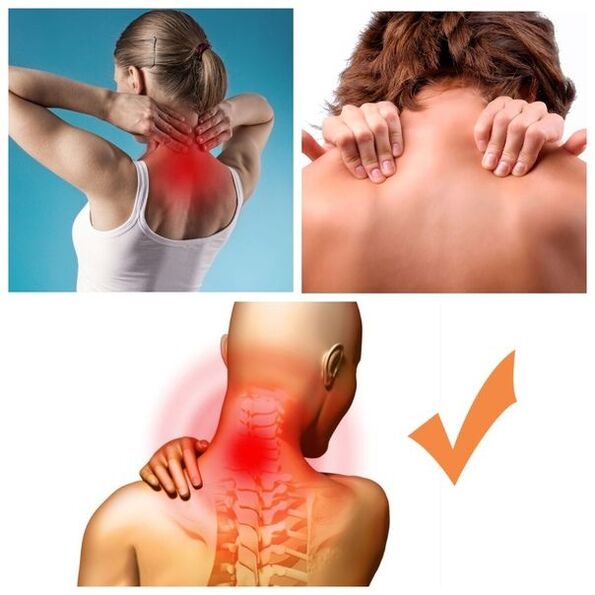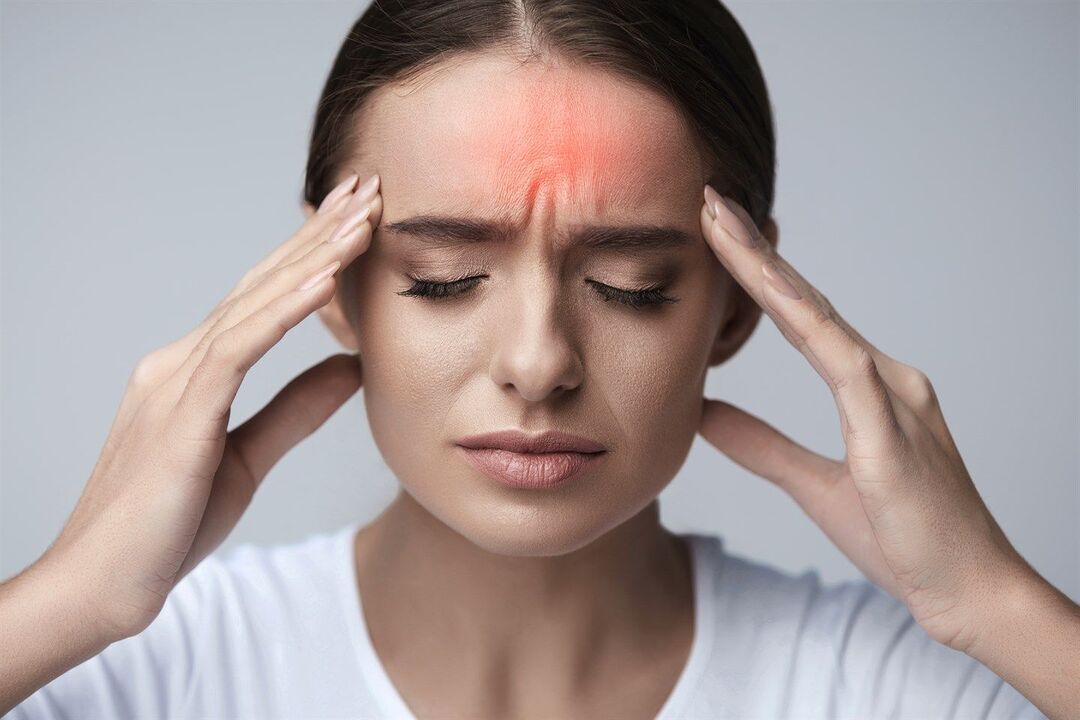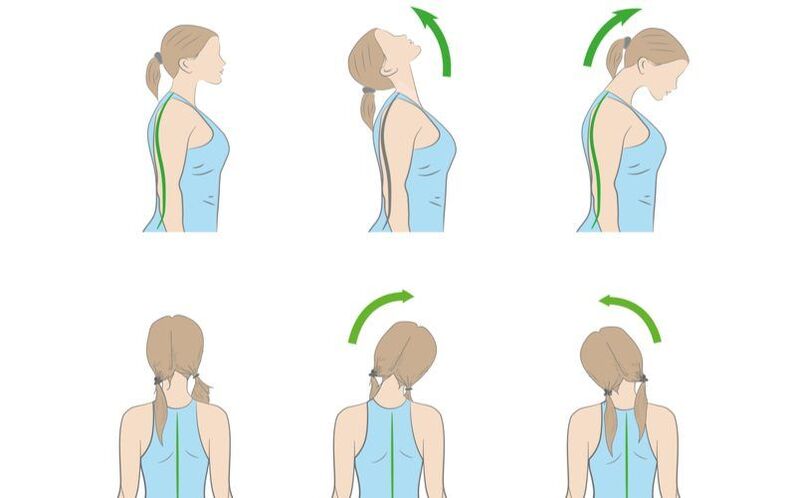Cervical osteochondrosis is a progressive degenerative-dystrophic lesion of the intervertebral discs between the first 7 vertebrae. Vertebrae 1-7 belong to the cervical spine.
Pathological changes against the background of osteochondrosis lead to deformation of the vertebrae, which ultimately leads to disruption of blood supply, nerve conduction in the neck and the innervation areas of damaged nerves.
Osteochondrosis of the cervical spine can be an independent disease or combined with osteochondrosis of other parts - thoracic and lumbar.
Main symptoms
The main symptom of cervical osteochondrosis is pain, the localization and nature of which depends on the location of the lesion. It is most commonly felt in the neck and collar area, one or both arms.
This disease is characterized by unilateral pain and any part of the arm can hurt - the shoulder, the forearm, the hand and even the fingers. Many patients complain of headaches and dizziness.
The pain syndrome can also be felt in the chest, supraclavicular area or the entire back. For some, the pain is concentrated in the base of the neck or throat.
Osteochondrosis of the cervical spine is characterized by a variety of symptoms and is often accompanied by impaired tactile sensitivity, muscle weakness, reduced visual and hearing acuity, palpitations and panic attacks.
Attention! Sometimes osteochondrosis is complicated by vertebral artery syndrome, which may require emergency hospitalization of the patient.
First signs
In the early stages, the manifestations of osteochondrosis are more like ordinary fatigue after a hard day and occur periodically. In the evening, there is discomfort and pain in the neck, heaviness and pain in the head, mainly in the occipital area. Possible crunching and creaking when turning the head.
Signs of cervical osteochondrosis are more pronounced in women than in men and are often accompanied by an unstable psycho-emotional state. In addition, men suffer from this disease much less often.
Exacerbation of chondrosis often occurs during menopause, when hormonal changes occur in the female body and the immune system is weakened. Due to the similar symptoms to many other diseases, certain difficulties arise in diagnosis.

The severity of symptoms depends on the stage of the disease, the type and degree of damage to the spine
Men react less to little things like a crunch in the neck and often simply don't notice suspicious symptoms. In addition, the symptoms of cervical osteochondrosis in men may not appear for a long time, which is explained by the peculiarities of the anatomy.
Men naturally have more pronounced and stronger muscles, which provides additional support for the spine. The muscular frame serves as a kind of armor that protects the vertebrae and prevents them from deforming.
Vertebral syndrome (VAS)
The clinical picture of SPA is usually represented by several symptoms, but only one of them can be observed:
- Headache with predominant localization in the back of the head and at the base of the skull - basilar migraine, accompanied by classic symptoms: loss of coordination, nausea leading to vomiting, tinnitus, less often - speech impairment;
- Dizziness that occurs when turning the head. They may be accompanied by vomiting, darkening of the eyes and impaired coordination of movements;
- Eye fatigue due to stress, flickering of spots and bright flashes in front of the eyes and loss of field of vision in some places. Patients may complain of pain, redness and a feeling of sand in the eyeballs, as well as inflammation of the conjunctiva;
- constant or episodic tinnitus, the type of which varies depending on the position of the neck. Mild deafness, blocked ears, and lack of responsiveness to a calm voice may occur. In some cases, paracusia has been identified - selective audibility of sounds, in which a person hears better in extraneous noise than in complete silence;
- Vegetative symptoms always appear when osteochondrosis worsens and are usually combined with other symptoms. These may include hot flashes or chills, increased sweating, cold feet and hands, a feeling of shortness of breath, increases in blood pressure and poor sleep;
- TIA - transient ischemic attacks - are associated with mechanical pinching of the vertebral artery and are manifested by double vision, temporary partial blindness with loss of visual field, dizziness with vomiting, speech and swallowing disorders;
- Fainting can be a result of sudden turns of the head or its uncomfortable position. Loss of consciousness varies in length of time and leaves weakness in the limbs;
- Drop attacks are sudden falls, usually without loss of consciousness, caused by a sudden rush of blood to the brain when the head is thrown back. The immediate cause is paralysis of the legs, but motor function recovers fairly quickly.
Headache and dizziness
Most patients with cervical chondrosis have this symptom, but it may be absent. The cause of dizziness is compression of the main arteries and blood vessels, which disrupts the transport of oxygen to the nerve tissue of the medulla oblongata and spinal cord.
Under the influence of mechanical trauma to the vertebral structures and chronic ischemia of nerve fibers, sensitivity increases and irritation of the nerve endings occurs, which ultimately leads to dizziness in the cervix.

A headache caused by chondrosis can be distinguished by its location in the back of the head. However, there are also not entirely typical cases in which the whole head or one side of it hurts
Dizziness can be accompanied by unsteady movement, increased heart rate, increases in blood pressure and increased sweating in the face and shoulder area.
Headaches are a common companion of cervical chondrosis. It is paroxysmal in nature, the duration of the attack varies from several hours to several days. The intensity of the pain varies, but it occurs with enviable regularity.
Headaches are caused by compression of the vertebral artery due to changes in position of the vertebrae and discs. Compression of the vessel disrupts the blood supply to the brain, resulting in pain.
Reference:
The cause of pain can also be muscle spasms, which are typical of osteochondrosis.
Panic attacks
Panic attacks are also accompanied by reduced brain nutrition and cause the following symptoms:
- attacks of fever or chills, increase in body temperature;
- Numbness, tingling in the limbs, muscle spasms, limited motor skills;
- dizziness, loss of coordination, darkening of the eyes;
- Pain behind the sternum or in the chest on the left, rapid pulse, increased blood pressure;
- insomnia, fear of death or mental confusion, confusion;
- Shortness of breath, difficulty breathing up to suffocation, lump in the throat;
- Malaise and pain in the abdomen, indigestion, frequent urination.
Sore throat
The neck usually hurts with osteochondrosis when the 4th cervical vertebra is damaged or displaced. The localization is usually one-sided, as the vertebrae and intervertebral discs shift to the side.

A sore throat is caused by impaired innervation of the throat muscles due to nerve compression
Cramping the roots causes cramps and tension in the throat muscles, accompanied by pain. The throat feels heavy and full and breathing becomes difficult. However, there are no mechanical obstacles to free breathing and swallowing, there are no foreign bodies or tumors in the esophagus and larynx.
It is typical that medications for tonsillitis or sore throats, rinses and inhalations have no effect.
The source of the pain is in the area between the thyroid cartilage and the cervical cavity. The type of pain ranges from mild to debilitating.
Treatment
The complex treatment of cervical osteochondrosis includes several methods – taking medications, performing therapeutic exercises, participating in physiotherapy and massage sessions. If desired, you can use folk remedies and make various compresses, prepare infusions and decoctions.
In case of exacerbation of the disease, it is recommended to maintain bed rest. In addition, you should lie on a flat and fairly hard, elastic surface - a sagging sofa or duvet will not work.
Attention! Severe pain requires immediate medical attention.
To fix the cervical spine, the doctor may prescribe wearing a Shants collar. It supports the neck in an anatomically correct position and eliminates movement and therefore pain.
The drug selection is made taking into account the existing symptoms and diagnostic results. If hernias and bulges are detected, treatment may be surgical.
| Drugs | action |
| Active ingredient: Pentoxifylline | Improves cerebral circulation, dilates blood vessels, relaxes smooth muscles and reduces the frequency of nerve signals |
| Preparations with chondroitin and glucosamine | Restoration of the cartilage tissue of the intervertebral discs, slowing down degenerative processes |
| Muscle relaxants | Relief from muscle spasms |
| Non-steroidal anti-inflammatory drugs | Relieving the inflammatory process, tissue swelling |
| Analgesics | Elimination of pain |
| Opioids | For severe pain that cannot be relieved with conventional remedies |
| Vitamin complexes with vitamins B, A, C, calcium | Strengthening of nerve, muscle and bone tissue, overall healing effect |
| Antidepressants and tranquilizers | Dealing with stress caused by constant pain |
Home treatment
It is not recommended to lie at home for too long and observe bed rest. After the acute symptoms subside, you must move on to active measures. You should start with simple exercises and gradually move on to more intense exercises.

Performing neck exercises will strengthen the neck muscles, preventing recurrence of exacerbations
Exercise 1 – Self-expansion. Stand with your arms along your body, tilt your head to the right and at the same time reach down with your left hand. Stay in this position and repeat the exercise on the other side.
Exercise 2 – Self-massage. Place the towel on your shoulders, hold the edges and pull it in one direction or the other.
Exercise 3 – Turn your head left and right, tilt to the right and then to your left shoulder.
Exercise 4 - the same with counteraction with the hand: Press on the temple when turning or tilting, this creates additional resistance.
Tips for preventing osteochondrosis
Tip #1
Physical education is the most important means of counteracting the aging of the body and the development of intervertebral disc dystrophy. Daily exercise and at least a weekly visit to the swimming pool are usually enough. All this allows you to strengthen the muscular corset of the spine.
Tip #2
Even a healthy person needs massage sessions; it is recommended to do them annually.
Tip #3
It is very important to monitor your weight and avoid weight gain.
Tip #4
If you work in a forced position for a long time, you need to take breaks, change your posture and warm up.
Tip #5
A good diet means getting enough vitamins and microelements with food.
Tip #6
Try not to lift or carry heavy objects. If necessary, wear a supportive corset.
FAQ
When do you need to see a doctor urgently?
The reasons for immediate consultation and even calling an ambulance are:
- persistent numbness in arms or legs;
- severe pain that is not relieved by conventional analgesics;
- movement disorder;
- severe headache, dizziness, loss of coordination and other signs of cerebrovascular accident;
- "Pinching" the back in a certain position, severely restricting movement.
Is it possible to cure chondrosis forever?
No, it is a chronic disease with periodic exacerbations. Even after treatment and following all the doctor's recommendations, the cartilage in the affected area of the intervertebral disc is replaced by scar tissue. That is, the structure of the segment is already damaged and this process is irreversible. However, with a little effort on the part of the patient, a high quality of life can be achieved.


























